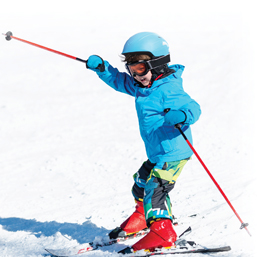
The idea of skiing with your kids may feel daunting. But, as the parents I interviewed for this piece agreed, it’s worth it. With a lot of planning (and maybe a little bribery) it’s totally do-able. Here are some things to consider before hitting the slopes.
1. When to start. The parents I spoke to agreed, the earlier kids start skiing, the more confident they’ll be and the more fun they’ll have. Mom Ellen Nordberg got her twins in ski lessons by age four and says, “Our kids are 13 now and committed skiers for life for having started so early.” Ian, a dad, recommends not rushing, but instead, waiting until your kids are “excited about skiing so they’re self-motivated.”
You may be wondering if your child is ready to ski. If that’s the case, Nate Chesley, a former ski instructor and dad, recommends asking yourself the following question: ‘How confident am I that my child will have fun [skiing]?’
According to Chesley, success is less about skiing and more about kids having the confidence to be separated from their parent(s), bundled up in bulky outerwear, trying to learn a new sport with foreign objects strapped to their feet. The key to a successful experience is making sure your child is having fun because “learning stops when the fun stops,” says Chesley. Even if your child spends half the lesson eating snowballs, if they’re smiling at the end and excited to try again, you can call it a win.
2. Manage expectations. Be honest with yourself about why you want your children to ski and what you hope they will accomplish. “Your motivations and expectations, and whether they’ve been met… will shape your child’s comfort and engagement [in skiing]. Push too hard, and you’re fighting against fear and discomfort.”
High expectations lead to disappointment. Mom Rebecca Johnson says kids “don’t care that you spent $80 to take one whiney run on the kiddie hill.” Moreover, if you pressure them, “they may not take another run in spite of you.” One of the dads I spoke to lets his kids choose whether to ski after their morning lesson in order to avoid meltdowns and to keep it fun.
3. Planning. From scheduling to packing a bag, planning saves stress, time, and money. Being organized means avoiding paying resort prices for a forgotten mitten. If possible, ski on weekdays. Crowds are lighter, and prices may be lower. Also, enroll your child in lessons in advance, as ski lessons can fill up quickly.
Arrive 15 minutes early for your child’s ski lesson to allow for unexpected delays and the inevitable bathroom stop once all of their gear is zipped and buttoned. Remember, kids pick up on your anxiety. If you’re stressed about running late, they will be, too.
4. The elements. Dressing in layers is key to staying warm. While kids’ bodies generally heat up faster than adults’, kids are more likely to complain about being too cold than too warm. If you can’t justify the cost of quality items your kid will wear for one season, try borrowing items or shop for good quality second-hand items.
Musts:
5. Gear. Most parents recommend renting skis and boots each season. Inquire at your local ski shop whether or not they have a trade-up program where you can trade last season’s gear for a bigger size at a discounted price the next season or trade out for the next size mid-season at no extra cost. If you rent skis for the day, prices are generally lower at a local ski shop than renting at the mountain. Renting locally also saves time at the ski resort.
That said, if you have multiple children, buying could make sense. Joy Jackson, mom of three, buys her kids’ equipment. “It gets handed down to the next child and I tune them better than the rental stores do.”
6. Proper nutrition. Allow time for the kids to eat a well-balanced breakfast. For picky eaters, consider serving them a favorite food (exception: Twizzlers). You could also pack something for them to munch on in the car, like a breakfast burrito or a sandwich.
Encourage your child to drink water, starting the day before skiing. Hydration is particularly important at altitude. But don’t force them to drink when they report feeling sick. When they puke, you’ll feel like the worst parent ever (that was my experience, anyway).
Snacks will help keep your child’s energy and mood up, plus they’re motivating. Parents cited candy, granola bars, and cheese sticks among prizes they keep in their pockets. Mom Joelle Wisler advises, “Don’t underestimate the power of bribery.”
7. Lessons. Parents overwhelmingly recommend turning kids over to professionals. If you plan to ski regularly, enrol them in a lesson that meets repeatedly with the same kids and instructors, so they get comfortable and make friends. Kids’ lessons also give you time to ski with your partner.
8. Fun factor. Parents and professionals agreed, for kids to enjoy skiing, it must be fun.
Strategies parents offered for upping the fun factor include:
I’m not going to sugar-coat it. Taking kids skiing is a lot of work and it is not cheap. As with any family activity, there are no guarantees against throwing tantrums, whining, or puking. But the rewards of sharing this sport with your kids more than make up for the hassles. And if you maintain low expectations, keep little toes warm, remember to bring candy, and focus on fun, you’ll be one step ahead of the game.
Pam is a freelance writer, occupational therapist, and certified personal trainer who helps women push through fear to become their best selves. To get her free guide to crushing Impostor Syndrome, visit pam-moore.com. This article was originally published on nuglow.com.
Calgary’s Child Magazine © 2024 Calgary’s Child